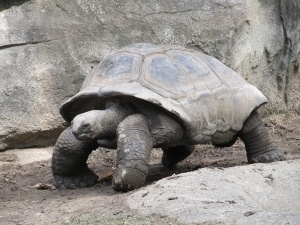
The sulcata tortoise is a unique pet to own and with it comes some unique problems like problems with its legs. This article looks into the problems that your sulcata tortoise may have.
Table of Contents
Sulcata tortoise leg problems:
The tortoise is already a slow animal on its feet and will be even slower if its legs develop problems.
Here are some problems that you’d want to look out for in your sulcata tortoise and how to address them:
Injury:
The more common issue that you may experience when raising your tortoise is an injury. The injury may be a strain or a broken leg.
A tortoise with an injury to its leg will not use its leg as normal and may limp around or tuck its leg into its shell to avoid pain when walking.
The animal may be quite loose in the injured leg when you pick it up.
What to do:
Keeping an eye on your pet, and watching if its condition gets better over 24 hours is recommended.
If your pet does not get better after the first 24 hours then you may have to take your tortoise to the vet. The vet will physically examine your pet and take an x-ray to see the extent of the damage.
Treatment may look like surgery and then bandaging the leg to the tortoise’s shell to keep the animal from using its leg until the leg is healed.
Abscess:
Another issue that your sulcata tortoise may be suffering from is an abscess in its leg. An abscess, from the outside, is a big bump on your pet’s leg and is a local infection caused by bacteria.
Reptiles are not mammals, so abscesses in tortoises won’t be the same as they are in mammals.
An abscess, on the skin of a mammal, is fluid-like and drains. Tortoise abscesses are hard and cheese-like and will continue to accumulate and not drain.
What to do:
Taking your pet to a vet, or better yet to a reptile specialist vet, is the recommended course of action.
The vet will examine your pet and likely take an x-ray to determine what is happening with your reptile.
If it is found that your turtle does have an abscess then the vet will open the abscess up and clean it out. Antibiotics may also be given to your turtle.
Metabolic bone disease:
If you find that your pet is unable to use one, or more, of its limbs, the legs included, then your pet may have a condition called metabolic bone disease.
Causes of metabolic bone disease in these animals are a lack of calcium or lack of UVB light. UVB light is essential as it helps the animal produce vitamin D.
If this condition is not treated then your pet may die a slow and painful death.
What to do:
If you think your pet has this condition then it is recommended that you add a daily dose of calcium to your pet’s food.
Giving your pet a tortoise cuttlebone is the best way to provide calcium to this animal. You can get cuttlebone in the bird section of your local pet store.
Making sure that you’re using a light that actually emits UVB light is also a must. These lights need to be replaced every 6 months as they start to lose their effectiveness after that.
The light should also be placed where there is no barrier, like a screen or a plastic cover, between it and the tortoise and it should be on for 12 hours a day.
If you enjoyed this article then you may also be interested in other tortoise/turtle related articles. Here are some articles that you may be interested in: Why Is My Tortoise Limping?, Tortoise Back Legs Stretched Out, Can Tortoises Break Their Legs?, Tortoise Having Trouble Walking, Tortoise Not Using One Leg, Why Does My Tortoise Bite His Leg?, Why Do Turtles Bite Their Feet?, Why Is My Turtle’s Back Leg Swollen?, Why Does My Turtle Sleep Standing Up?

